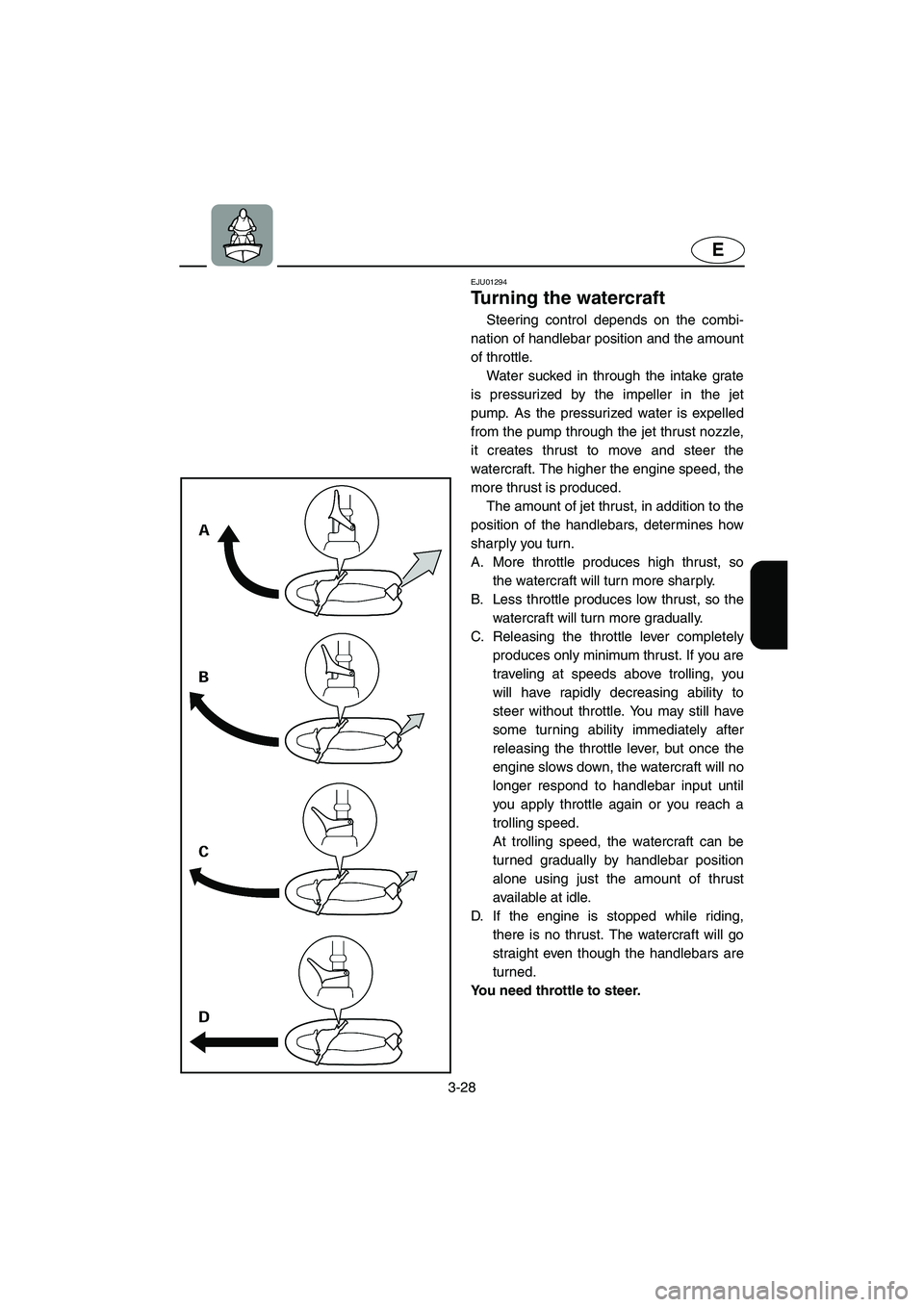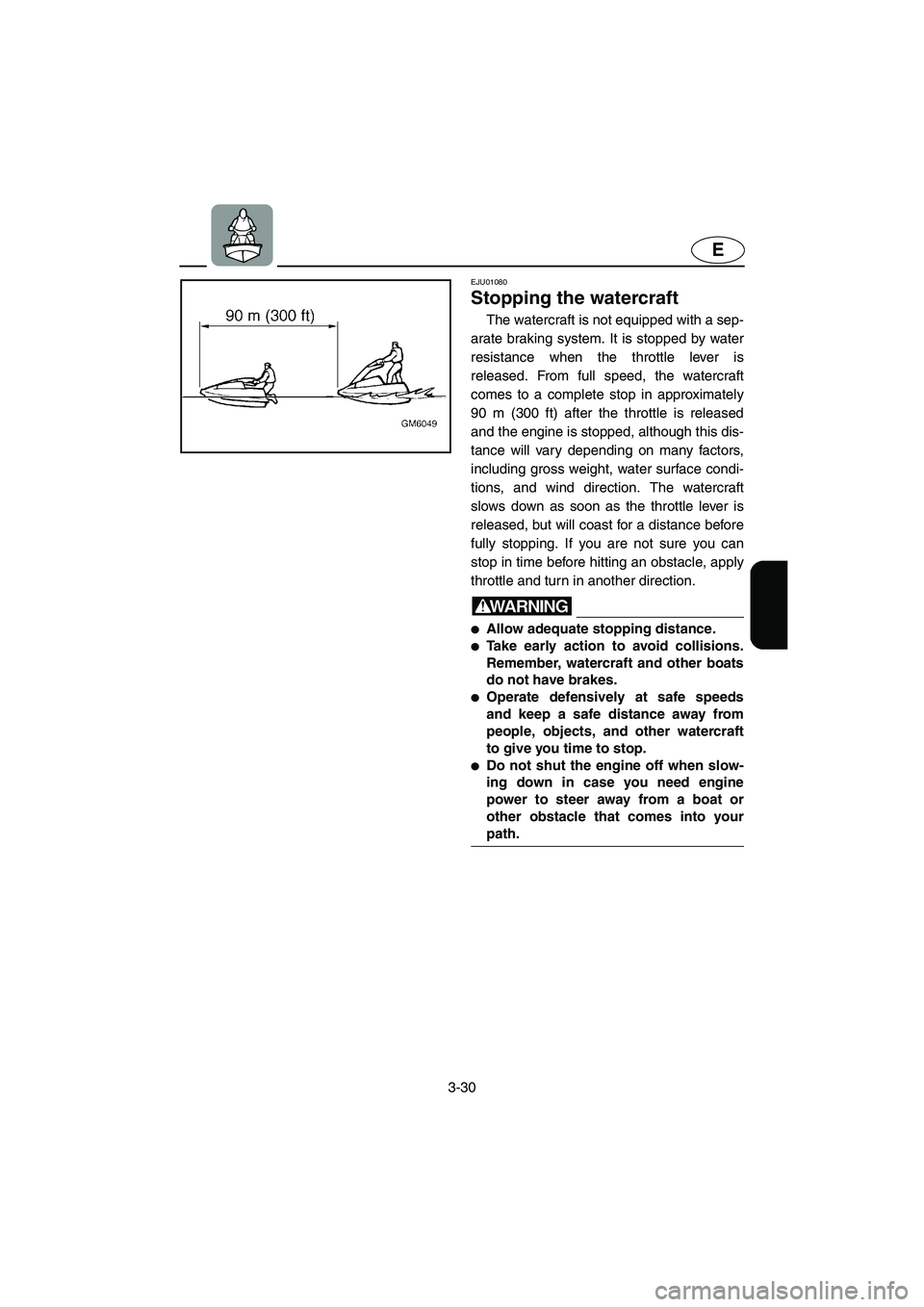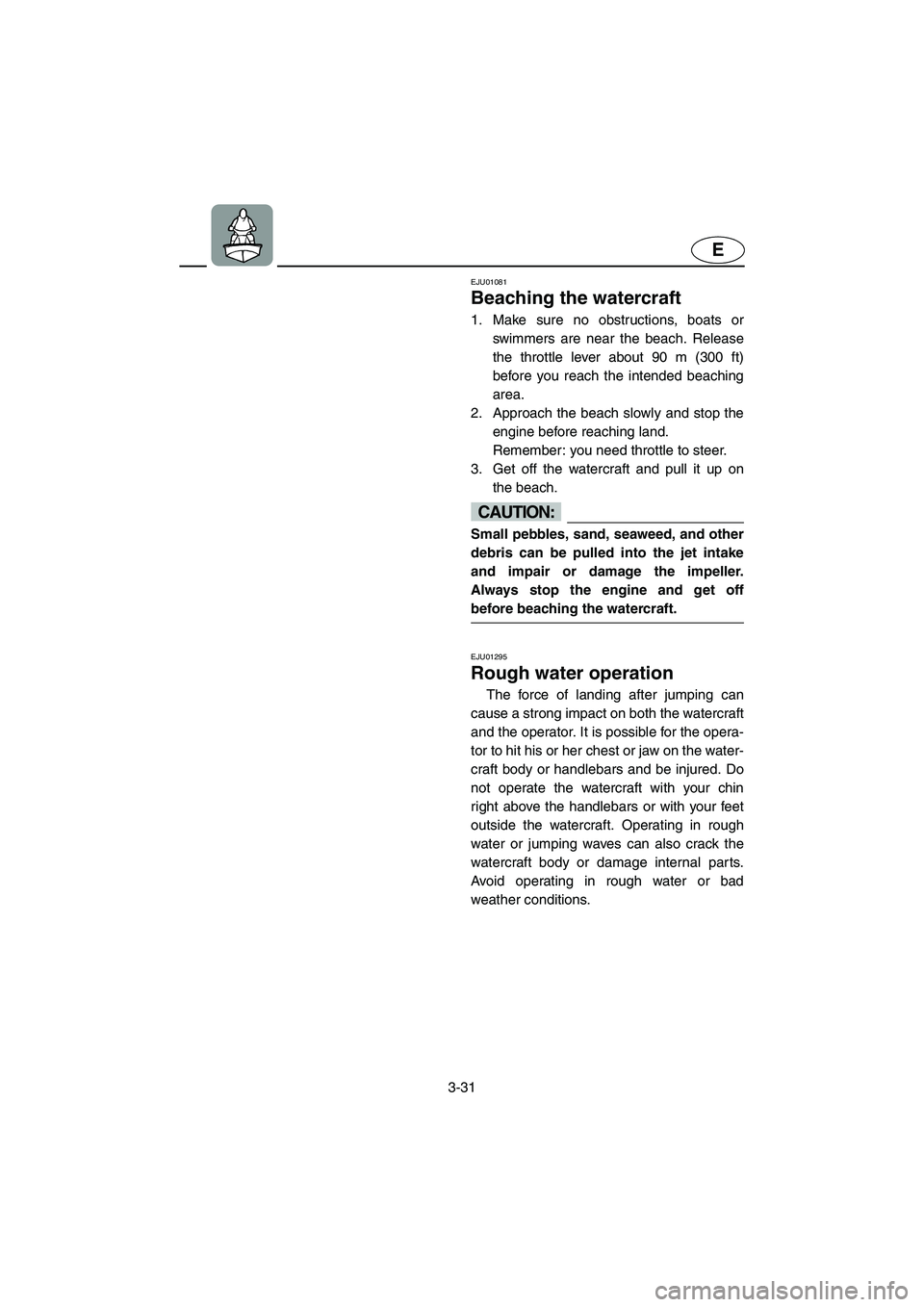Page 55 of 106
3-22
E
EJU01378
Boarding and starting in deep
water
1. Swim to the rear of the watercraft. Attach
the engine shut-off cord to your wrist.
Attach the clip to the engine shut-off
switch.
2. Grasp the handlebars with both hands.
Pull your body up onto the riding tray and
balance there, using your elbows on the
gunwales for leverage.
3. Start the engine and begin to accelerate.
4. Continue to pull your body up onto the
watercraft as the watercraft speed
increases.
5. Bring your knees up onto the riding tray
and change to a kneeling position as
soon as you can do so.
WARNING@ Avoid forceful jet thrust and limited visi-
bility while reboarding. Get to standing
or kneeling position quickly, but do not
expose yourself to forceful jet thrust.
@
UF1N73.book Page 22 Monday, May 10, 2004 10:37 AM
Page 57 of 106
3-24
E
EJU01289
Boarding and starting in shallow
water
Be sure to learn the deep-water starting
method before operating the watercraft in
water where it is too deep for you to stand.
Do not try to start the watercraft in water
less than 60 cm (2 ft) deep.
1. Launch the watercraft into water.
2. Attach the engine shut-off cord to your
wrist. Attach the clip to the engine
shut-off switch.
3. Grip the handlebars with both hands.
Place one knee on the riding tray and
balance there.
4. Start the engine and begin to accelerate.
5. Pull your other knee up onto the riding
tray as the watercraft speed increases.
6. Move as far forward as possible without
interfering with the movement of the han-
dlebars. Keep your body perpendicular
to the water, with your weight forward
and low.
NOTE:@ The watercraft will become easier to bal-
ance as the speed increases, because jet
thrust provides stability as well as directional
control.
@
UF1N73.book Page 24 Monday, May 10, 2004 10:37 AM
Page 59 of 106

3-26
E
EJU12931
Capsized watercraft
If the watercraft capsizes, turn it over
immediately.
Be sure to carefully follow the procedures
below to prevent injury or damage to the
watercraft.
WARNING@ IMPROPER UPRIGHTING CAN CAUSE
INJURY:
�Shut the engine off by pulling on the
engine shut-off cord to remove the clip
from the engine shut-off switch.
�Do not put your hands in the intake
grate.
@
CAUTION:@ Be sure to remove the clip from the
engine shut-off switch to shut the engine
off, otherwise the engine can overheat,
which can result in severe engine dam-
age.
@
1. Shut the engine off by removing the clip
from the engine shut-off switch.
2. Swim to the rear of the watercraft and
upright it by turning it clockwise only.
NOTE:@ If the port (left) side of the capsized water-
craft is tilting up, push down on the gunwale
so that the port (left) side is down before
turning the watercraft clockwise.
@
CAUTION:@ Do not turn the watercraft over counter-
clockwise, otherwise water can leak into
the carburetor and engine, which can
result in severe damage.
@
UF1N73.book Page 26 Monday, May 10, 2004 10:37 AM
Page 60 of 106
3-27
E
3. Start the engine and operate the water-
craft to discharge any water remaining in
the engine compartment. (If the engine
does not start, see page 5-6, “Towing the
watercraft” or page 5-7, “Submerged
watercraft.”)
NOTE:@ �To efficiently discharge water from the
engine compartment, operate the water-
craft as straight as possible and above
planing speed for at least 2 minutes.
�To stabilize the watercraft when accelerat-
ing to planing speed, maintain a low cen-
ter of gravity by operating it in the
kneeling position.
@
UF1N73.book Page 27 Monday, May 10, 2004 10:37 AM
Page 61 of 106

3-28
E
EJU01294
Turning the watercraft
Steering control depends on the combi-
nation of handlebar position and the amount
of throttle.
Water sucked in through the intake grate
is pressurized by the impeller in the jet
pump. As the pressurized water is expelled
from the pump through the jet thrust nozzle,
it creates thrust to move and steer the
watercraft. The higher the engine speed, the
more thrust is produced.
The amount of jet thrust, in addition to the
position of the handlebars, determines how
sharply you turn.
A. More throttle produces high thrust, so
the watercraft will turn more sharply.
B. Less throttle produces low thrust, so the
watercraft will turn more gradually.
C. Releasing the throttle lever completely
produces only minimum thrust. If you are
traveling at speeds above trolling, you
will have rapidly decreasing ability to
steer without throttle. You may still have
some turning ability immediately after
releasing the throttle lever, but once the
engine slows down, the watercraft will no
longer respond to handlebar input until
you apply throttle again or you reach a
trolling speed.
At trolling speed, the watercraft can be
turned gradually by handlebar position
alone using just the amount of thrust
available at idle.
D. If the engine is stopped while riding,
there is no thrust. The watercraft will go
straight even though the handlebars are
turned.
You need throttle to steer.
UF1N73.book Page 28 Monday, May 10, 2004 10:37 AM
Page 63 of 106

3-30
E
EJU01080
Stopping the watercraft
The watercraft is not equipped with a sep-
arate braking system. It is stopped by water
resistance when the throttle lever is
released. From full speed, the watercraft
comes to a complete stop in approximately
90 m (300 ft) after the throttle is released
and the engine is stopped, although this dis-
tance will vary depending on many factors,
including gross weight, water surface condi-
tions, and wind direction. The watercraft
slows down as soon as the throttle lever is
released, but will coast for a distance before
fully stopping. If you are not sure you can
stop in time before hitting an obstacle, apply
throttle and turn in another direction.
WARNING@ �Allow adequate stopping distance.
�Take early action to avoid collisions.
Remember, watercraft and other boats
do not have brakes.
�Operate defensively at safe speeds
and keep a safe distance away from
people, objects, and other watercraft
to give you time to stop.
�Do not shut the engine off when slow-
ing down in case you need engine
power to steer away from a boat or
other obstacle that comes into your
path.
@
UF1N73.book Page 30 Monday, May 10, 2004 10:37 AM
Page 64 of 106

3-31
E
EJU01081
Beaching the watercraft
1. Make sure no obstructions, boats or
swimmers are near the beach. Release
the throttle lever about 90 m (300 ft)
before you reach the intended beaching
area.
2. Approach the beach slowly and stop the
engine before reaching land.
Remember: you need throttle to steer.
3. Get off the watercraft and pull it up on
the beach.
CAUTION:@ Small pebbles, sand, seaweed, and other
debris can be pulled into the jet intake
and impair or damage the impeller.
Always stop the engine and get off
before beaching the watercraft.
@
EJU01295
Rough water operation
The force of landing after jumping can
cause a strong impact on both the watercraft
and the operator. It is possible for the opera-
tor to hit his or her chest or jaw on the water-
craft body or handlebars and be injured. Do
not operate the watercraft with your chin
right above the handlebars or with your feet
outside the watercraft. Operating in rough
water or jumping waves can also crack the
watercraft body or damage internal parts.
Avoid operating in rough water or bad
weather conditions.
UF1N73.book Page 31 Monday, May 10, 2004 10:37 AM
Page 65 of 106

3-32
E
EJU01894
Post-operation checks
Always perform the following post-opera-
tion checks after operating the watercraft.
1. Remove the watercraft from the water.
2. Wash down the hull, steering pole, han-
dlebars, and jet unit with fresh water.
3. Remove the hood and check the engine
compartment for water. To drain excess
water, turn the watercraft on its port (left)
side. If necessary, turn the watercraft
upside down to drain water completely.
CAUTION:@ �Place a suitable clean cloth or carpet-
ing underneath the watercraft to pro-
tect it from abrasions and scratches.
�Always turn the watercraft over onto
its port (left) side.
�When turning the watercraft onto its
side or inverting it, support the bow
and secure the steering pole, other-
wise the steering pole and handlebars
could be bent or damaged.
@
NOTE:@ This watercraft is equipped with an auto-
matic bilge-draining system that removes
water from the engine compartment while
you are underway. However, some residual
water will remain.
@
4. Put the watercraft in a horizontal posi-
tion.
5. Flush the cooling system to prevent it
from clogging with salt, sand, or dirt.
(See page 4-1 for flushing the cooling
system procedures.)
6. Drain residual water from the exhaust
system by alternately squeezing and
releasing the throttle lever for 10 to
15 seconds while the engine is running.
UF1N73.book Page 32 Monday, May 10, 2004 10:37 AM